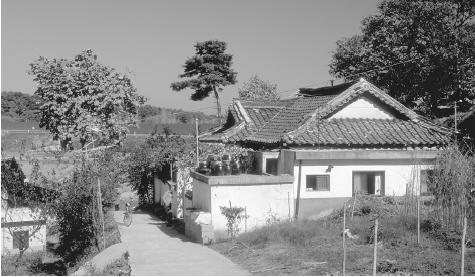Emergence of the Nation. The Korean peninsula has been inhabited for more than half a million years, and a Neolithic culture emerged around 6,000 B.C.E. The legendary beginning date of the Korean people is said to be 2333 B.C.E. , when Tan'gun established the kingdom of Choson ("Morning Freshness," often translated as the "Land of Morning Calm") around today's P'yongyang. To distinguish it from the later Choson Dynasty, it is now referred to as Ko ("Old") Choson.
In the legend, Tan'gun was born of a divine father, Hwan-ung, a son of the heavenly king, and a woman who had been transformed from a bear. The bear and a tiger had pleaded with Hwan-ung to transform them into human beings. Only the bear achieved the transformation by following Hwanung's instructions, which included a hundred-day seclusion to avoid sunlight and the ingestion of a bunch of mugwort ( ssuk ) and twenty pieces of garlic. This bear turned woman then married Hwan-ung, and their offspring was Tan'gun. A recent interpretation of the bear woman is that she came from a bear totem tribe.
The Old Choson period is divided into the Tan'gun, Kija, and Wiman periods. Shortly after the fall of Wiman Choson in 108 B.C.E. and the establishment of Chinese military control in the north, the Three Kingdoms (Silla, Koguryo, and Paekche) period began. In 668, Silla unified the Three Kingdoms. Silla's decline in the late ninth century brought about the rise of Later Paekche and Later Koguryo. Wang Kon, who established the Koryo Dynasty, eventually reunified the nation. A series of Mongol invasions that began in 1231 devastated the country in the thirteenth and fourteenth centuries. General Yi Song-gye overthrew Koryo and established the Choson Dynasty in 1392. Despite invasions by Japan and Manchu (Qing) in the sixteenth and seventeenth centuries, respectively, Choson continued for more than five centuries until 1910, when Japan colonized the nation for three and a half decades.
National Identity. Before the 1945 national division of the peninsula and the subsequent establishment of the two political regimes of North and South Korea in 1948, Koreans identified themselves as the people of Choson. Tan'gun as the founding ancestor has had a symbolic meaning for Koreans throughout the nation's history. A temple erected in Tan'gun's honor in 1429 stood in P'yongyang until its destruction during the Korean War. In 1993, North Korea announced the discovery of Tan'gun's tomb and a few remains of his skeleton at a site close to P'yongyang. Some Korean calendars still print the Year of Tan'gun ( Tan'gi ) along with the Gregorian calendar year, which the South Korean government officially adopted in 1962.
Ethnic Relations. Korea is one of the few countries in which ethnicity and nationality coincide. The only immigrant ethnic minority group is a Chinese community of about 20,000 that is concentrated mainly in Seoul and has existed since the late nineteenth century. Since the Korean War, the continued presence of the United States Forces–Korea has resulted in the immigration of over one hundred thousand Korean women to the United States as

soldiers' wives. Since the early 1990s, an increasing number of foreign workers from Asian countries (including Korean Chinese) and Russia have entered South Korea in pursuit of the "Korean Dreams."
In the legend, Tan'gun was born of a divine father, Hwan-ung, a son of the heavenly king, and a woman who had been transformed from a bear. The bear and a tiger had pleaded with Hwan-ung to transform them into human beings. Only the bear achieved the transformation by following Hwanung's instructions, which included a hundred-day seclusion to avoid sunlight and the ingestion of a bunch of mugwort ( ssuk ) and twenty pieces of garlic. This bear turned woman then married Hwan-ung, and their offspring was Tan'gun. A recent interpretation of the bear woman is that she came from a bear totem tribe.
The Old Choson period is divided into the Tan'gun, Kija, and Wiman periods. Shortly after the fall of Wiman Choson in 108 B.C.E. and the establishment of Chinese military control in the north, the Three Kingdoms (Silla, Koguryo, and Paekche) period began. In 668, Silla unified the Three Kingdoms. Silla's decline in the late ninth century brought about the rise of Later Paekche and Later Koguryo. Wang Kon, who established the Koryo Dynasty, eventually reunified the nation. A series of Mongol invasions that began in 1231 devastated the country in the thirteenth and fourteenth centuries. General Yi Song-gye overthrew Koryo and established the Choson Dynasty in 1392. Despite invasions by Japan and Manchu (Qing) in the sixteenth and seventeenth centuries, respectively, Choson continued for more than five centuries until 1910, when Japan colonized the nation for three and a half decades.
National Identity. Before the 1945 national division of the peninsula and the subsequent establishment of the two political regimes of North and South Korea in 1948, Koreans identified themselves as the people of Choson. Tan'gun as the founding ancestor has had a symbolic meaning for Koreans throughout the nation's history. A temple erected in Tan'gun's honor in 1429 stood in P'yongyang until its destruction during the Korean War. In 1993, North Korea announced the discovery of Tan'gun's tomb and a few remains of his skeleton at a site close to P'yongyang. Some Korean calendars still print the Year of Tan'gun ( Tan'gi ) along with the Gregorian calendar year, which the South Korean government officially adopted in 1962.
Ethnic Relations. Korea is one of the few countries in which ethnicity and nationality coincide. The only immigrant ethnic minority group is a Chinese community of about 20,000 that is concentrated mainly in Seoul and has existed since the late nineteenth century. Since the Korean War, the continued presence of the United States Forces–Korea has resulted in the immigration of over one hundred thousand Korean women to the United States as

A house in Oh Ju Kon village, Kangnung, South Korea, reflects a more modern approach to South Korean rural housing.

Tidak ada komentar:
Posting Komentar